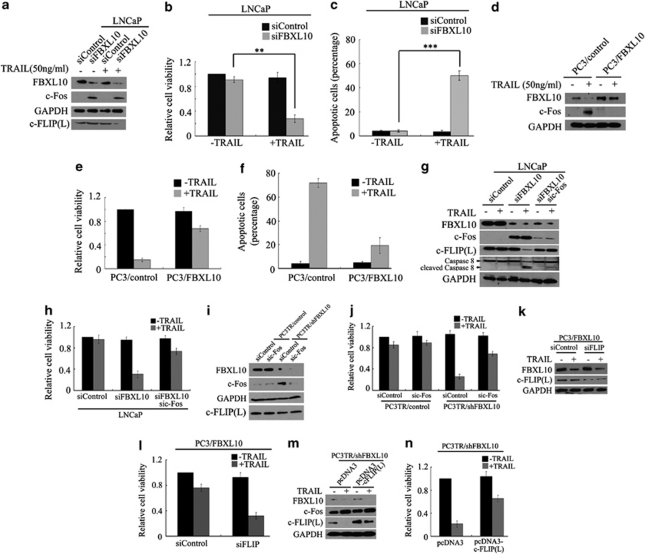Figure 4.
FBXL10 regulates sensitivity/resistance of cancer cells to TRAIL. (a–c) LNCaP cells transfected with FBXL10 or control siRNA for 40 h were treated with TRAIL (50 ng/ml) for additional 8 h. (a) immunoblot, (b) MTT cell viability and (c) Annexin V assays. Results are shown as the mean (bar) ± S.D. of at least three independent experiments. (d–f) PC3 cells stably transfected with FBXL10 or control plasmids were treated with TRAIL (50 ng/ml) for 8 h: (d) immunoblot, (e) MTT cell viability and (f) Annexin V assay. (g and h) LNCaP cells transfected with FBXL10, c-Fos or control siRNA were treated with TRAIL (50 ng/ml): (g) immunoblot and (h) MTT cell viability assay. (i and j) PC3TR cells were stably transfected with shFBXL10 or control plasmids to generate stable cells. The stable cells transfected with c-Fos siRNA or control siRNA for 40 h were treated with TRAIL (50 ng/ml) for additional 8 h: (i) immunoblot and (j) MTT cell viability. (k and l) Stable PC3/FBXL10 cells transfected with FLIP siRNA or control siRNA for 40 h were treated with TRAIL (50 ng/ml) for additional 8 h: (k) immunoblot and (l) MTT cell viability assay. (m and n) Stable PC3TR/shFBXL10 cells transfected with pcDNA3-c-FLIP or control pcDNA3 for 40 h were treated with TRAIL (50 ng/ml) for additional 8 h: (m) Immunoblot and (n) MTT cell viability assay. The data represent means of average determinants ± S.E.M. **P<0.01; ***P<0.001

